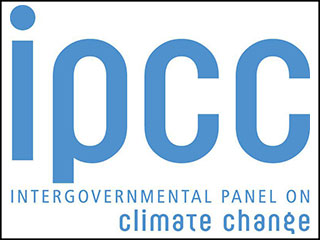I think you trust the knowledge and wisdom of politicians way too much and science way too little.You would think Obama would know about it given his mansion is next to the Atlantic Ocean. I think Biden also owns a mansion close to the Atlantic ocean.
Navigation
Install the app
How to install the app on iOS
Follow along with the video below to see how to install our site as a web app on your home screen.
Note: This feature may not be available in some browsers.
More options
You are using an out of date browser. It may not display this or other websites correctly.
You should upgrade or use an alternative browser.
You should upgrade or use an alternative browser.
STOP worrying Earth is getting hotter
- Thread starter Robert W
- Start date
CO2 is a relatively weak GHG. 1C per doubling of CO2 is nothing.Guess the 350 ppm safety valve is long since gone, and I seriously doubt very many climate scientists thought it was even possible to maintain that goal, we are in a runaway feedback loop now, with the forecast for an increasing CO2 concentration to enter the earths atmosphere. Surprisingly, the worst emitter of this is the ruminant stomachs of cattle from humans need for beef.
Which leads back to my original statement about accelerated feedback loops. You know how you clear out for a cattle farm in the Amazon? First you cut down and remove everything from the land, and then you burn everything, to remove any traces of it. You've not only elimiated a carbon sink, but you've insured that vegetation won't grow back, one of which compounds the other.
Another example: India experiencing record high temperatures that are killing people, and this from the worlds most populated nation on earth, of which about 10% have use of an air conditioner. As temps, rise, so do the contributors as more A/C is used.
One situation making another far worse, and it was already bad.
I think it's the other way around. It's you who has put too much faith in politicians which is why you have never take the time to study the history of the planet's climate as I have. CO2 is a relatively weak GHG compared to water vapor. The majority of heat is in the ocean not the atmosphere. It's the ocean coupled with the unique landmass configuration which has thermally isolated the north pole from warm marine currents which drives the planet's climate.I think you trust the knowledge and wisdom of politicians way too much and science way too little.
You mean like these:I think it's the other way around. It's you who has put too much faith in politicians which is why you have never take the time to study the history of the planet's climate as I have. CO2 is a relatively weak GHG compared to water vapor. The majority of heat is in the ocean not the atmosphere. It's the ocean coupled with the unique landmass configuration which has thermally isolated the north pole from warm marine currents which drives the planet's climate.
AMERICAN SCIENTIFIC SOCIETIES
Statement on Climate Change from 18 Scientific Associations
"Observations throughout the world make it clear that climate change is occurring, and rigorous scientific research demonstrates that the greenhouse gases emitted by human activities are the primary driver." (2009)2-

American Association for the Advancement of Science
"Based on well-established evidence, about 97% of climate scientists have concluded that human-caused climate change is happening." (2014)3 
American Chemical Society
"The Earth’s climate is changing in response to increasing concentrations of greenhouse gases (GHGs) and particulate matter in the atmosphere, largely as the result of human activities." (2016-2019)4
American Geophysical Union
"Based on extensive scientific evidence, it is extremely likely that human activities, especially emissions of greenhouse gases, are the dominant cause of the observed warming since the mid-20th century. There is no alterative explanation supported by convincing evidence." (2019)5
American Medical Association
"Our AMA ... supports the findings of the Intergovernmental Panel on Climate Change’s fourth assessment report and concurs with the scientific consensus that the Earth is undergoing adverse global climate change and that anthropogenic contributions are significant." (2019)6
American Meteorological Society
"Research has found a human influence on the climate of the past several decades ... The IPCC (2013), USGCRP (2017), and USGCRP (2018) indicate that it is extremely likely that human influence has been the dominant cause of the observed warming since the mid-twentieth century." (2019)7
American Physical Society
"Earth's changing climate is a critical issue and poses the risk of significant environmental, social and economic disruptions around the globe. While natural sources of climate variability are significant, multiple lines of evidence indicate that human influences have had an increasingly dominant effect on global climate warming observed since the mid-twentieth century." (2015)8
The Geological Society of America
"The Geological Society of America (GSA) concurs with assessments by the National Academies of Science (2005), the National Research Council (2011), the Intergovernmental Panel on Climate Change (IPCC, 2013) and the U.S. Global Change Research Program (Melillo et al., 2014) that global climate has warmed in response to increasing concentrations of carbon dioxide (CO2) and other greenhouse gases ... Human activities (mainly greenhouse-gas emissions) are the dominant cause of the rapid warming since the middle 1900s (IPCC, 2013)." (2015)9
SCIENCE ACADEMIES
International Academies: Joint Statement
"Climate change is real. There will always be uncertainty in understanding a system as complex as the world’s climate. However there is now strong evidence that significant global warming is occurring. The evidence comes from direct measurements of rising surface air temperatures and subsurface ocean temperatures and from phenomena such as increases in average global sea levels, retreating glaciers, and changes to many physical and biological systems. It is likely that most of the warming in recent decades can be attributed to human activities (IPCC 2001)." (2005, 11 international science academies)10
U.S. National Academy of Sciences
"Scientists have known for some time, from multiple lines of evidence, that humans are changing Earth’s climate, primarily through greenhouse gas emissions."11
U.S. GOVERNMENT AGENCIES

U.S. Global Change Research Program
"Earth’s climate is now changing faster than at any point in the history of modern civilization, primarily as a result of human activities." (2018, 13 U.S. government departments and agencies)12
INTERGOVERNMENTAL BODIES

Intergovernmental Panel on Climate Change
“It is unequivocal that the increase of CO2, methane, and nitrous oxide in the atmosphere over the industrial era is the result of human activities and that human influence is the principal driver of many changes observed across the atmosphere, ocean, cryosphere, and biosphere.
“Since systematic scientific assessments began in the 1970s, the influence of human activity on the warming of the climate system has evolved from theory to established fact.”13-17
OTHER RESOURCES
List of Worldwide Scientific Organizations
The following page lists the nearly 200 worldwide scientific organizations that hold the position that climate change has been caused by human action.List of Worldwide Scientific Organizations - Office of Planning and Research
U.S. Agencies
The following page contains information on what federal agencies are doing to adapt to climate change.https://www.c2es.org/site/assets/up...daptation-what-federal-agencies-are-doing.pdf
In which peer-reviewed journal should I look for your theories?I think it's the other way around. It's you who has put too much faith in politicians which is why you have never take the time to study the history of the planet's climate as I have. CO2 is a relatively weak GHG compared to water vapor. The majority of heat is in the ocean not the atmosphere. It's the ocean coupled with the unique landmass configuration which has thermally isolated the north pole from warm marine currents which drives the planet's climate.
Great. So when you can explain how the planet transitioned from a greenhouse planet to an icehouse planet and the 30 or so glacial cycles that have occurred over the last 3 million years, get back to me. Because until then, you don't know jack shit.You mean like these:
AMERICAN SCIENTIFIC SOCIETIES
Statement on Climate Change from 18 Scientific Associations
"Observations throughout the world make it clear that climate change is occurring, and rigorous scientific research demonstrates that the greenhouse gases emitted by human activities are the primary driver." (2009)2

American Association for the Advancement of Science
"Based on well-established evidence, about 97% of climate scientists have concluded that human-caused climate change is happening." (2014)3
American Chemical Society
"The Earth’s climate is changing in response to increasing concentrations of greenhouse gases (GHGs) and particulate matter in the atmosphere, largely as the result of human activities." (2016-2019)4
American Geophysical Union
"Based on extensive scientific evidence, it is extremely likely that human activities, especially emissions of greenhouse gases, are the dominant cause of the observed warming since the mid-20th century. There is no alterative explanation supported by convincing evidence." (2019)5
American Medical Association
"Our AMA ... supports the findings of the Intergovernmental Panel on Climate Change’s fourth assessment report and concurs with the scientific consensus that the Earth is undergoing adverse global climate change and that anthropogenic contributions are significant." (2019)6
American Meteorological Society
"Research has found a human influence on the climate of the past several decades ... The IPCC (2013), USGCRP (2017), and USGCRP (2018) indicate that it is extremely likely that human influence has been the dominant cause of the observed warming since the mid-twentieth century." (2019)7
American Physical Society
"Earth's changing climate is a critical issue and poses the risk of significant environmental, social and economic disruptions around the globe. While natural sources of climate variability are significant, multiple lines of evidence indicate that human influences have had an increasingly dominant effect on global climate warming observed since the mid-twentieth century." (2015)8
The Geological Society of America
"The Geological Society of America (GSA) concurs with assessments by the National Academies of Science (2005), the National Research Council (2011), the Intergovernmental Panel on Climate Change (IPCC, 2013) and the U.S. Global Change Research Program (Melillo et al., 2014) that global climate has warmed in response to increasing concentrations of carbon dioxide (CO2) and other greenhouse gases ... Human activities (mainly greenhouse-gas emissions) are the dominant cause of the rapid warming since the middle 1900s (IPCC, 2013)." (2015)9SCIENCE ACADEMIES
International Academies: Joint Statement
"Climate change is real. There will always be uncertainty in understanding a system as complex as the world’s climate. However there is now strong evidence that significant global warming is occurring. The evidence comes from direct measurements of rising surface air temperatures and subsurface ocean temperatures and from phenomena such as increases in average global sea levels, retreating glaciers, and changes to many physical and biological systems. It is likely that most of the warming in recent decades can be attributed to human activities (IPCC 2001)." (2005, 11 international science academies)10

U.S. National Academy of Sciences
"Scientists have known for some time, from multiple lines of evidence, that humans are changing Earth’s climate, primarily through greenhouse gas emissions."11U.S. GOVERNMENT AGENCIES

U.S. Global Change Research Program
"Earth’s climate is now changing faster than at any point in the history of modern civilization, primarily as a result of human activities." (2018, 13 U.S. government departments and agencies)12INTERGOVERNMENTAL BODIES

Intergovernmental Panel on Climate Change
“It is unequivocal that the increase of CO2, methane, and nitrous oxide in the atmosphere over the industrial era is the result of human activities and that human influence is the principal driver of many changes observed across the atmosphere, ocean, cryosphere, and biosphere.
“Since systematic scientific assessments began in the 1970s, the influence of human activity on the warming of the climate system has evolved from theory to established fact.”13-17OTHER RESOURCES
List of Worldwide Scientific Organizations
The following page lists the nearly 200 worldwide scientific organizations that hold the position that climate change has been caused by human action.
List of Worldwide Scientific Organizations - Office of Planning and Research
U.S. Agencies
The following page contains information on what federal agencies are doing to adapt to climate change.
https://www.c2es.org/site/assets/up...daptation-what-federal-agencies-are-doing.pdf
As soon as the theory of AGW is dead, you won't be able to swing a dead cat without hitting one. Until then there's no money for them to write about anything other than the politicized AGW.In which peer-reviewed journal should I look for your theories?
But hey, if the empirical climate data showing a cooling planet for millions of years with atmospheric CO2 greater than 600 ppm and 30 glacial cycles which occurred over the last 3 million years isn't enough proof for you, then I can only assume your mind won't change until your masters tell you think different.
But if you are interested in understanding what really drives the climate of the planet I suggest you do some research on what would happen when the AMOC collapses. Because when that does happen AGAIN, there will be no denying it and they will start doing real science and not political science.
I know Jack, he's a great guy and speaks so well of you. According to him:Great. So when you can explain how the planet transitioned from a greenhouse planet to an icehouse planet and the 30 or so glacial cycles that have occurred over the last 3 million years, get back to me. Because until then, you don't know jack shit.
- Research points to plate tectonics and volcanic activity changing a greenhouse planet to an icehouse planet.
- Glacials and interglacials occur in fairly regular repeated cycles. The timing is governed to a large degree by predictable cyclic changes in Earth’s orbit, which affect the amount of sunlight reaching different parts of Earth’s surface. The three orbital variations are: (1) changes in Earth’s orbit around the Sun (eccentricity), (2) shifts in the tilt of Earth’s axis (obliquity), and (3) the wobbling motion of Earth’s axis (precession).
So you're asking if CO2 is a factor in global warming? I don't know and I don't care. Is man causing global warming? I don't know and I don't care. Is the planet warming? Yes it is, I have seen it with my own eyes, and that is something I do care about. If you want to argue the root cause, I'm not a climate scientist so you'll have to look elsewhere.As soon as the theory of AGW is dead, you won't be able to swing a dead cat without hitting one. Until then there's no money for them to write about anything other than the politicized AGW.
But hey, if the empirical climate data showing a cooling planet for millions of years with atmospheric CO2 greater than 600 ppm and 30 glacial cycles which occurred over the last 3 million years isn't enough proof for you, then I can only assume your mind won't change until your masters tell you think different.
But if you are interested in understanding what really drives the climate of the planet I suggest you do some research on what would happen when the AMOC collapses. Because when that does happen AGAIN, there will be no denying it and they will start doing real science and not political science.
- Sep 9, 2022
- 14,713
- 6,581
- 938
- Thread starter
- #71
I don't trust the politicians who operate as if they are scientists.I think you trust the knowledge and wisdom of politicians way too much and science way too little.
I don't trust politicians who claim a global, scientific conspiracy that advocates a position against the ideology of that politician.I don't trust the politicians who operate as if they are scientists.
- Sep 9, 2022
- 14,713
- 6,581
- 938
- Thread starter
- #73
75% of Earth is covered by water. One might think they would catch the clue.I think it's the other way around. It's you who has put too much faith in politicians which is why you have never take the time to study the history of the planet's climate as I have. CO2 is a relatively weak GHG compared to water vapor. The majority of heat is in the ocean not the atmosphere. It's the ocean coupled with the unique landmass configuration which has thermally isolated the north pole from warm marine currents which drives the planet's climate.
How did plate tectonics result in a transition from a greenhouse planet to an icehouse planet?Research points to plate tectonics and volcanic activity changing a greenhouse planet to an icehouse planet.
How do orbital changes trigger glacial periods and end glacial periods? What temperature affect do orbital changes have on the planet?Glacials and interglacials occur in fairly regular repeated cycles. The timing is governed to a large degree by predictable cyclic changes in Earth’s orbit, which affect the amount of sunlight reaching different parts of Earth’s surface. The three orbital variations are: (1) changes in Earth’s orbit around the Sun (eccentricity), (2) shifts in the tilt of Earth’s axis (obliquity), and (3) the wobbling motion of Earth’s axis (precession).
Yes, the planet warms up during relatively brief interglacial periods and then reverses itself during long periods of frigid temperatures.So you're asking if CO2 is a factor in global warming? I don't know and I don't care. Is man causing global warming? I don't know and I don't care. Is the planet warming? Yes it is, I have seen it with my own eyes, and that is something I do care about. If you want to argue the root cause, I'm not a climate scientist so you'll have to look elsewhere.
Yes, increased and decreased CO2 does have an impact on surface temperatures but it is a relatively weak GHG. For every doubling of CO2 surface temperatures will rise by 1C. For every halving of CO2 surface temperatures will reduce by 1C. So surface temperaqtures are more sensitive to reduced CO2 than it is to increased CO2. Doubling: 280 to 560 to 1120. Halving: 420 to 210 to 105.
So based upon the simple physics of radiative forcing a 120 ppm increase from 300 ppm to 420 ppm will result in an increase of 0.5C. The rest of the warming is from the planet naturally warming back up to its pre-glacial temperature before it reverses itself for the next glacial cycle. Which has been occurring for the last 3 million years. And all of that was due to glaciation in the northern hemisphere.
How did plate tectonics result in a transition from a greenhouse planet to an icehouse planet?
Plate tectonic carbon cycle explains how Earth maintains a Goldilocks climate
26 May, 2022 by Dietmar MüllerEarth’s hot and cold climates driven by tectonic plate speeds
A new study has revealed how the plate tectonic carbon cycle maintains a “Goldilocks climate” on Earth that is neither too hot nor too cold.
It is now established that CO2 emissions from burning fossil fuels are driving atmospheric CO2 above 400 parts per million (ppm), causing global warming. But what caused climate change millions of years ago, before humans arrived on the scene?
An international team led by Professor Dietmar Müller at the University of Sydney’s School of Geosciences has modelled Earth’s carbon cycle over the last 250 million years to find the answer.
Their results, published in Nature, suggest that speeding tectonic plates cause greenhouse climates, while slow-moving plates can tip the Earth into an icehouse climate.
From hothouse to icehouse
A hothouse climate occurs when the planet has no ice sheets. In the Cretaceous Period (~145-66 million years ago), atmospheric CO2 rose above 1000 ppm, causing mean annual temperatures to be up to 10°C hotter than today. The sweltering heat led to a thriving dinosaur population in lush forests of ferns, cycads, and conifers and triggered the evolution of flowering plants and bees, key parts of our terrestrial ecosystems.
The team used a computer-generated model to show that the Cretaceous greenhouse climate was caused by tectonic plates moving extremely fast. Through a series of environmental interactions, this led to a doubling of CO2 emissions along mid-ocean ridges.
The Earth’s climate was transformed into an ice age in the subsequent Cenozoic Era, after 66 million years ago. Ice ages typically initiate when atmospheric CO2 falls below 300 ppm, cooling the planet below a climate threshhold where inland ice sheets form. A cooling trend started around 50 million years ago, leading to Antarctic glaciation about 15 million years later, when an inland ice sheet started developing on Antarctica. But how did the Earth start cooling around 50 million years ago?
Slowing tectonic plates have been thought to cool the planet simply by reducing the volcanic emissions of CO2 along less active plate boundaries. However, Müller’s team showed that this process was offset in the Cenozoic by increasing volcanic CO2 emissions from deep-sea carbonate sediments that are recycled back into the deep Earth along subduction zones, where plates dive into the Earth’s hot interior.
This process is so effective in emitting CO2 that it more than offsets the reduced CO2 emissions due to the slowing down of plate tectonics. Therefore slowing plates must have had another way to extract CO2 from the atmosphere and store it away. The answer lies in the mountain chains that were responsible for slowing down the plates in the first place.
The role of mountains and deep-sea sediments
When the supercontinent Pangea started breaking apart 200 million years ago, the continents didn’t have much mountainous topography. As the Pangea progressively disintegrated, new ocean gateways formed, and eventually the widely dispersed continents started running into each other, creating massive mountains from the Himalayas to the Alps, starting around 50 million years ago and slowing plate tectonics down.
The new model implies that slowing plates cooled the climate with the aid of eroding mountains, with erosion products, including carbon, ultimately being stored away in ocean sediments. As soon as mountains form, they start being eroded. Rainwater containing CO2 reacts with a range of mountain rocks, breaking them down and rivers carry dissolved minerals into the sea.
The Cretaceous hothouse climate preceding the Cenozoic cooling had an unexpected benefit: it triggered the evolution and diversification of tiny sea creatures, plankton and algae, that live in the sunlit waters of the surface ocean and build their shells or skeletons from dissolved carbonate, provided by erosion on the continents. When they die, they fall to the seafloor, storing away carbon in deep-sea sediment layers that became thicker and thicker after the Cretaceous.
The increasing volume of carbonate deep-sea sediments partly reflects a falling sea level, gradually eliminating many shallow seas that covered the continents during the Cretaceous, and shifting carbonate production out into the ocean. However, it appears that the increasing volume of deep-sea carbonate sediments also reflects the increasing supply of erosion products from the continents. Massive amounts of CO2, therefore, became stored away, and the planet cooled, even though a portion of this new oceanic carbonate sediment reservoir was subducted and emerged again as CO2 through arc volcanoes.
Rock weathering and carbon capture on human timescales
The balance between volcanism and erosion, and sedimentation, emitting or storing away carbon, ultimate ensures that the Earth remains habitable. Can we make use of any of these geological processes for carbon capture over the next decades?
Published laboratory experiments have shown that the weathering of dark igneous rocks, containing the green mineral olivine in abundance, is efficient in removing CO2 from the atmosphere. This had led to the proposal of a negative emissions technology that enhances silicate weathering along coasts, accelerating the geological silicate weathering mechanism to become useful for carbon capture on human timescales.
One idea is that the volcanic mineral olivine would be spread across coastal areas to make green sand beaches. Waves help breaks down the rock, accelerating a reaction that removes CO2 from the atmosphere. This process could be harnessed to absorb up to a trillion tonnes of carbon dioxide from the atmosphere.
However, the current speed of human-induced warming is so rapid that geological processes alone, even if engineered as negative emissions technologies, cannot work fast enough to retain a ‘goldilocks’ climate. Therefore, we will also need to reduce emissions to avoid a hothouse climate that would potentially make many regions on Earth uninhabitable.
WHAT CAUSES ICE AGES?What is an ice age? An ice age is a period in Earth's history when the ice onthe polar caps significantly expands due to a lowering of the Earth's globaltemperatures. Over the course of millions of years, scientists believe that theEarth has experienced at least five major ice ages. During these periods land inNorth America and Northern Europe were covered by giant ice sheets andglaciers. Earth is currently in an ice age called the Quaternary Ice Age whichbegan around 2.5 million years ago and is still going on. We are currently in aninterglacial stage of this ice age. The periods within ice ages are defined as:Glacial- A glacial period is a cold period when the glaciers areexpanding.Interglacial- A warming period when the glaciers and ice sheetsare receding.INTERGLACIAL PERIOD GLACIAL PERIOD2Student Sheet 2What causes an ice age? The Earth is constantly undergoing changes. Thesechanges can impact the global climate. Some of the changes that can influencean ice age include:Earth's orbit - Changes in the Earth's orbit (called Milankovitch cycles) cancause the Earth to be closer to the Sun (warmer) or further from theSun(colder). Ice ages can occur when we are further from the Sun.Solar energy - The amount of energy output by the Sun also changes. Low cyclesof energy output can possibly help in producing an ice age.Atmospheric composition - Low levels of greenhouse gasses such as carbondioxide can cause the Earth to cool leading to an ice age.Ocean currents-can have a great impact on the Earth's climate. Changes incurrents can cause ice sheets to build up.Volcanoes - introduce huge amounts of carbon dioxide into the atmosphere. Thelack of volcanoes can cause an ice age. Increased volcanic activity can put an endto an ice age as wellThere really is no simple answer to the question of why ice ages occur; thereare many different and interconnected causes. In general, it is felt that iceages are caused by a chain reaction of positive feedbacks triggered byperiodic changes in the Earth’s orbit around the Sun. These feedbacks,involving the spread of ice and the release of greenhouse gases, work in reverseto warm the Earth up again when the orbital cycle shifts back. The last ice ageended about 12,000 years ago. The next cooling cycle would be expected tostart about 30,000 years or more into the future.Many theories have been proposed to explain the causes of ice ages. Anycredible theory must explain what caused the ice to build up, how and why theice advanced and retreated at different times during a glaciation and why theice eventually disappeared. One theory that tries to explain these phenomena isthe Ocean–Control Theory. The diagram on the next page illustrates thistheory.3Student Sheet 3THE OCEAN-CONTROL THEORYStudent Sheet 4ANALYSIS: Study the feedback loop of the Ocean-Control Theoryof ice age formation and then complete thefollowing activities.The oceans may control the advance and retreatof glaciers and ice ages.Less precipitationLittleevaporationColdoceansWarmoceansWarm runoff beginsto warm the oceansWith less precipitation more snowmelts than builds up. Glaciers retreatHow do orbital changes trigger glacial periods and end glacial periods? What temperature affect do orbital changes have on the planet?
So we agree the planet is currently warming. It may cool again but that is on a geologic time scale, not a human one. Humanity will suffer just as much if the warming is natural as if it is man-made.Yes, the planet warms up during relatively brief interglacial periods and then reverses itself during long periods of frigid temperatures.
Yes, increased and decreased CO2 does have an impact on surface temperatures but it is a relatively weak GHG. For every doubling of CO2 surface temperatures will rise by 1C. For every halving of CO2 surface temperatures will reduce by 1C. So surface temperaqtures are more sensitive to reduced CO2 than it is to increased CO2. Doubling: 280 to 560 to 1120. Halving: 420 to 210 to 105.
So based upon the simple physics of radiative forcing a 120 ppm increase from 300 ppm to 420 ppm will result in an increase of 0.5C. The rest of the warming is from the planet naturally warming back up to its pre-glacial temperature before it reverses itself for the next glacial cycle. Which has been occurring for the last 3 million years. And all of that was due to glaciation in the northern hemisphere.
Toddsterpatriot
Diamond Member
So we agree the planet is currently warming. It may cool again but that is on a geologic time scale, not a human one. Humanity will suffer just as much if the warming is natural as if it is man-made.
That's awful!
Fewer weather-related deaths, longer growing seasons and higher crop yields.
We're doomed!!!
Similar threads
- Replies
- 84
- Views
- 432
Latest Discussions
- Replies
- 8
- Views
- 27
- Replies
- 20
- Views
- 98
- Replies
- 50
- Views
- 170
- Replies
- 84
- Views
- 269
Forum List
-
-
-
-
-
Political Satire 8513
-
-
-
-
-
-
-
-
-
-
-
-
-
-
-
-
-
-
-
ObamaCare 781
-
-
-
-
-
-
-
-
-
-
-
Member Usernotes 483
-
-
-
-
-
-
-
-
-
-